Supplemental Supporting Statement Part A for Substantive Changes April 2022
0218 - Supporting Statement A for ARMS & Chemical Use Surveys - Substantive Change for Underserved - April 2022.docx
Agricultural Resource Management and Chemical Use Surveys
Supplemental Supporting Statement Part A for Substantive Changes April 2022
OMB: 0535-0218
SUPPLEMENTAL SUPPORTING STATEMENT Part A
ARMS 1, ARMS 2, ARMS 3, Fruit Chemical Use Survey and State Cooperative Surveys
Substantive Change
OMB No. 0535-0218
This substantive change is being submitted as a supplemental supporting statement to the existing clearance for the Agricultural Resource Management Surveys (ARMS), the Fruit Chemical Use Survey, and State Cooperative Chemical Use Surveys.
A. JUSTIFICATION
Circumstances making collection of information necessary.
The National Agricultural Statistics Service (NASS) is requesting a substantive change to the ARMS and Chemical Use Survey docket (OMB No. 0535-0218) for the 2022 ARMS Phase 1 (Screening Survey), ARMS Phase 2, Chemical Use, and ARMS Phase 3 (Costs and Returns Survey). The change is needed for two purposes:
Announce target commodities for the 2022 cycle, and
to collect data from additional historically underserved farm producer groups.
NASS conducts the ARMS program as a part of a cooperative agreement with the USDA Economic Research Service (ERS). In addition, the USDA Office of Pest Management Policy (OPMP) has provided input on the ARMS 2 (chemical use survey) as well as the Fruit and Vegetable Chemical Use Surveys. The Costs and Returns (Phase 3) surveys collect both whole farm data and commodity specific data. The whole farm data can be linked to the cropping practices and chemical use data collected in the ARMS 2 phase. The majority of the questions that are asked in the Phase 3 surveys are part of the ARMS core program and rarely have any changes made to them. The cooperative agreement allows ERS to ask additional research questions each year to address changes in the farming industry. The OMB approval process is for a three-year period, so NASS projects ahead with the surveys and commodities that will be targeted for the next three years. Each year NASS will provide changes to the questionnaires to OMB for approval.
The target commodities for the 2022 cycle are: wheat (winter, Durum, and other spring wheat), potatoes, and vegetable chemical use.
This substantive change is in response to the Biden Administration’s top priority of advancing equity for all Americans. As stated by the White House, “President Biden is putting equity at the center of the agenda with a whole of government approach to embed racial justice across Federal agencies, policies, and programs.” (Retrieved March 15, 2022, from https://www.whitehouse.gov/priorities/.) The U.S. Department of Agriculture (USDA) is contributing to the President’s agenda by making racial justice and equity one of the top USDA priorities (Retrieved March 15, 2022, from https://www.usda.gov/media/radio/weekly-features/2021-02-09/what-are-tom-vilsacks-priorities-usda).
According to the USDA’s Fiscal Year 2022 (FY22) Goals and Priorities:
Advancing Racial Justice, Equity and Opportunity: USDA is committed to the values of equity and inclusion rooted in justice and equal opportunity for our employees and those we serve. USDA is taking bold, historic action to reduce barriers to access, advance opportunity for underserved communities, and root out generations of systemic racism and discrimination. This includes embracing diversity, equity, inclusion, and access in the workplace and ensuring USDA is a great place to work with a well-trained and diverse workforce committed to its customers. In FY22, we will continue to build on our progress towards integrating equity into decision-making and programs and services.
(Retrieved March 15, 2022, from https://www.fs.usda.gov/inside-fs/mail-call/usda-first-friday-peoples-department-serves-our-people.)
USDA Secretary Tom Vilsack recently stated, “We must see to it that the programs we support and the investments we make are available to all and that we take distinct action in ensure that historically underserved farmers and ranchers are able to participate in USDA programs and benefit from the opportunities USDA investments and programs can help create.” (Retrieved March 15, 2022, from https://www.usda.gov/media/press-releases/2021/10/07/usda-commitments-equity-agriculture-include-nearly-25-million.)
USDA’s ERS and NASS are partnering to support President Biden’s and USDA’s priority to advance racial justice, equity, and opportunity by providing more detailed data and research on the socioeconomic characteristics of farmers and ranchers in the United States to ensure all USDA policies and decisions are inclusive of all people the Department serves. In order to meet these objectives, it is essential to modify the sampling methodology for the ARMS to gather additional information from historically underserved groups. This effort will ensure USDA is able to provide data about the financial well-being and other characteristics for historically underserved groups.
ARMS data are the primary source of information for the USDA on a broad range of issues related to agricultural resource use, costs of production, farm sector financial conditions, and farm household well-being. ARMS is the only annual source of whole farm information available for objective evaluation of many critical issues related to agriculture and the rural economy. The additional information from historically underserved groups can be used to estimate operator’s household income, credit/debt levels, USDA program participation outcomes, and other economic farm/ranch data and ensure USDA is meeting the President’s and USDA’s priorities to ensure policies and program serve all people, regardless of race, ethnicity, or income.
How, by whom, and for what purpose information is to be used.
In addition to the long list of data users of the ARMS and chemical use data that was provided in the original approval, this substantive change will provide the ERS and researchers with data to better understand and assess the financial health and needs of historically underserved farm producer groups.
ERS has spoken and worked with several groups regarding underserved farmers and ranchers including the General Accountability Office (GAO), USDA - Farm Production and Conservation (FPAC), and Secretary of Agriculture. Below are some recent examples of data and analyses on underserved farmers and ranchers for USDA and Congress. Please note that some of the data requests will result in publications. ERS will likely incorporate the data in their standard publications which will adhere to their normal publication schedules. In addition, ERS has the expectation that the data will be used to generate additional reports, bulletins, and journal articles. These additional publications do not have an established timeline but given the high level of interest in this topic, it is likely these projects will be given priority in terms of staff resources and publication space. ERS also anticipates that having data on underserved farmers and ranchers will generate discussion with other government agencies interested in using these data to help gage how well they are serving this population.
USDA-FPAC Business Center requested help on heirs property using ARMS for the Cost-Benefit Analysis in the Heirs Property Relending Program. https://www.regulations.gov/document/FSA-2021-0002-0001. See discussion on page 12-16 and citation of ERS contribution to the analysis in footnote 28. ERS has continued to engage on heirs property issues with USDA-FPAC Business Center and other stakeholders.
Section 12607 of the 2018 farm bill (P.L. 115-334) “Reports on land access and farmland ownership data collection”. The responsibility for writing this report was delegated by the Secretary of Agriculture to the Economic Research Service and the report is presently in inter-agency clearance.
Section 5416 of the 2018 farm bill (P.L. 115-334) “GAO report on credit services to socially disadvantaged farmers and ranchers”. GAO-19-539 drew on ARMS data tabulation and analysis carried out by ERS.
Section 1005 of the American Rescue Plan (P.L. 117-2) “Farm loan assistance for socially disadvantaged farmers and ranchers”. Analysis for the announcement of availability of funding drew on ARMS analysis of income and debt profiles of socially disadvantaged farmers and ranchers. This analysis was included in staff analysis requested by FPAC-Business Center in developing decision memos at the USDA Under Secretary level.
In development: “An Overview of Farms Operated by Socially Disadvantaged, Women, and Limited Resource Farmers and Ranchers in the United States”. This report will be entering into peer review this fiscal year.
Use of improved information technology.
There are no changes from the original approval.
4. Efforts to identify duplication.
There are no changes from the original approval related to duplication reduction.
Methods to minimize burden of small businesses.
With the use of the CATI and CAWI instruments, the incorporated screening questions and skip patterns should help minimize burden as much as possible.
Consequence if information collection were less frequent.
There are no changes to the frequency of these surveys from what was originally approved.
Special circumstances.
No special circumstances are associated with this information collection.
Federal register notice and consultation with outside persons.
ERS consulted with staff from General Accountability Office (GAO) and USDA’s Office of the Secretary of Agriculture as well as USDA’s Farm Production and Conservation (FPAC),
Payments or gifts to respondents.
No payments or gifts will be given to respondents.
Confidentiality provided to respondents.
This substantive change request does not change the confidentiality provisions from the original approval. These provisions include the following.
Questionnaires include a statement that individual reports are confidential. U.S. Code Title 18, Section 1905; U.S. Code Title 7, Section 2276; and Title III of Pub. L. No. 115-435 (CIPSEA) provide for confidentiality of reported information. All NASS employees, all enumerators hired and supervised under a cooperative agreement with the National Association of State Departments of Agriculture (NASDA), and all NASS contractors must either receive annual training or sign a statement attesting to compliance with the confidentiality provisions.
The following confidentiality pledge statement will appear on all NASS questionnaires.
The information you provide will be used for statistical purposes only. Your responses will be kept confidential and any person who willfully discloses ANY identifiable information about you or your operation is subject to a jail term, a fine, or both. This survey is conducted in accordance with the Confidential Information Protection and Statistical Efficiency Act of 2018, Title III of Pub. L. No. 115-435, codified in 44 U.S.C. Ch. 35 and other applicable Federal laws. For more information on how we protect your information please visit: https://www.nass.usda.gov/confidentiality. Response to this survey is voluntary.
Questions of a sensitive nature.
No questions of sensitive nature will be asked.
12. Hour burden and annualized costs to respondents.
The following tables in this question contain the estimated burden hours for the surveys included in this supplemental supporting statement.
The lines in purple are changes.
Revisions for 2022 – sheet 1
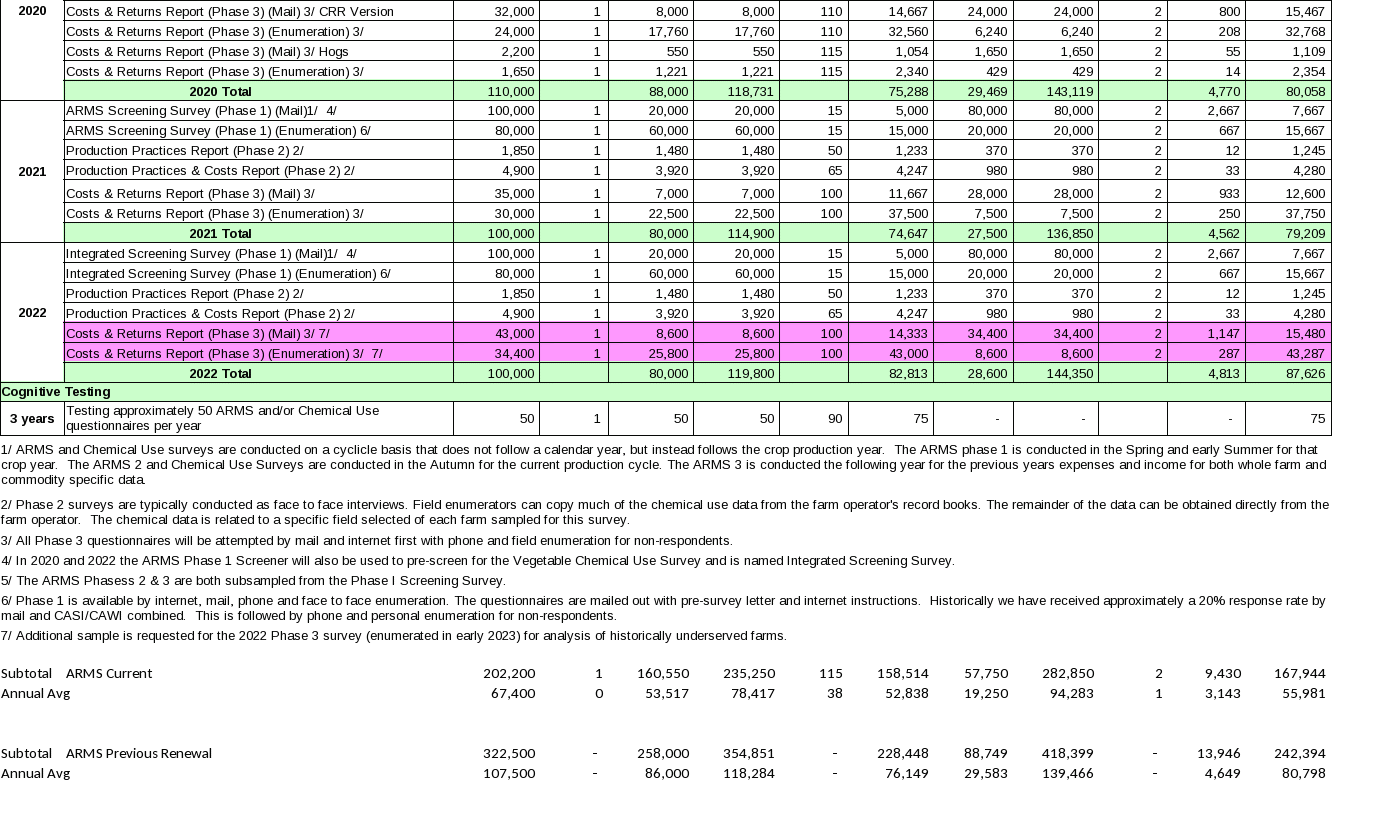
Revisions for 2022 – sheet 2
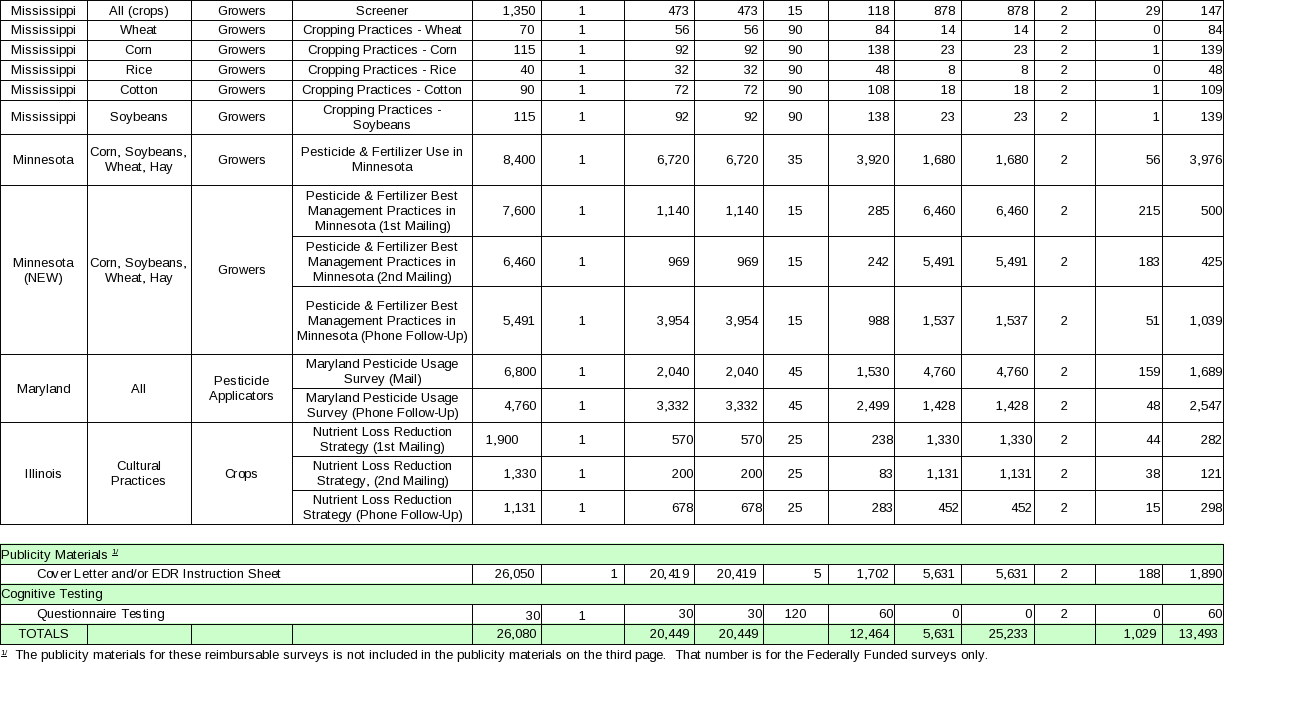
Revisions for 2022 - sheet 3
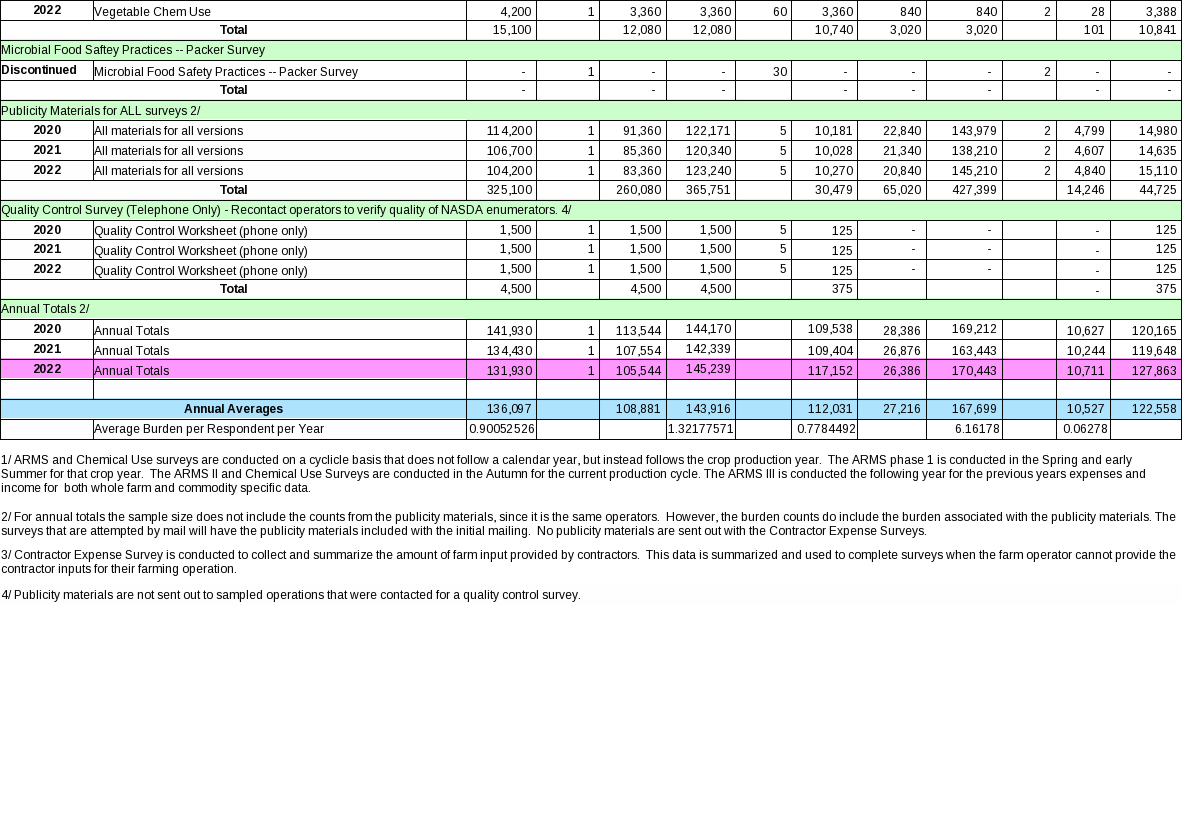
The targeted commodities for the 2022 cycle are:

NOTE ON CRR/CENSUS: Respondents will have the option of completing the ARMS 3 questionnaire and not having to complete the Census of Agriculture. The ARMS 3 questionnaire contains the same essential questions as the Census of Agriculture.
Cost to the public for completing the questionnaire is assumed to be comparable to the hourly rate of those requesting the data. The adjusted overall cost to the public is estimated at $4,727,095.11.
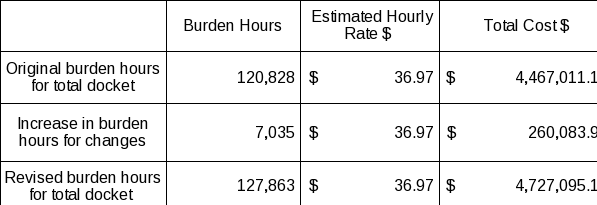
NASS uses the Bureau of Labor Statistics’ Occupational Employment Statistics (most recently published on March 31, 2021 for the previous May) to estimate an hourly wage for the burden cost. The May 2020 mean wage for bookkeepers was $21.20. The mean wage for farm managers was $36.93. The mean wage for farm supervisors was $25.25. The mean wage of the three is $27.79. To calculate the fully loaded wage rate (includes allowances for Social Security, insurance, etc.) NASS will add 33% for a total of $36.97 per hour.
Total annual cost burden to respondents.
No start-up or ongoing operation/maintenance costs are associated with this information collection.
Annualized costs to federal government.
An interagency agreement with the Economic Research Service is providing an additional $500,000 for this research. This results in a total cost of $18,500,000 for the Agricultural Resource Management Surveys and the Chemical Use programs.
Reasons for changes in burden.
The change in respondents, number of responses, and burden are primarily due to the change in the Phase 3 sample size (Additional samples, multiple contacts, and 100 minutes per completed report) is to provide enough competed reports for USDA and other researchers to understand and assess the financial health and needs of historically underserved farm producer groups. Due to the COVID-19 pandemic in 2020, 2021, and early 2022 resulted in the need for social distancing, NASS and our enumerators have had to alter the modes of data collection to begin using internet responses and an increase in data collection by telephone. Depending on the status of the pandemic, personal enumeration may be used for the Phase 2 and Phase 3 surveys again.
The below table highlights the change from what was previously approved.
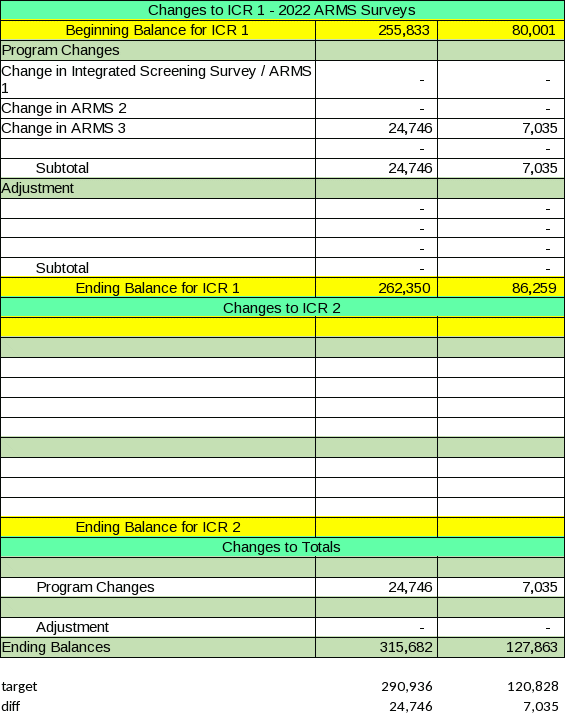
Tabulation, analysis, and publication plans.
ERS will likely incorporate the data in this change request in their standard publications which will adhere to their normal publication schedules. In addition, ERS has the expectation that the data will be used to generate additional reports, bulletins, and journal articles. These additional publications do not have an established timeline but given the high level of interest in this topic it is likely that these projects will be given priority in terms of staff resources and publication space.
Request for approval of non-display of expiration date.
No request is being made for approval of non-display of the expiration date.
18. Exceptions to certification statement.
No exceptions to the certification statement are requested.
April 2022
| File Type | application/vnd.openxmlformats-officedocument.wordprocessingml.document |
| Author | HancDa |
| File Modified | 0000-00-00 |
| File Created | 2022-06-22 |
© 2026 OMB.report | Privacy Policy